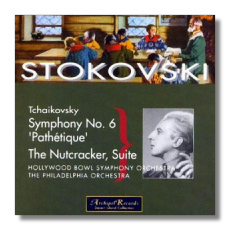
The Internet's Premier Classical Music Source
Related Links
-
Mahler Reviews
Tchaikovsky Reviews - Latest Reviews
- More Reviews
-
By Composer
-
Collections
DVD & Blu-ray
Books
Concert Reviews
Articles/Interviews
Software
Audio
Search Amazon
Recommended Links
Site News
 CD Review
CD Review
Stokowski on Archipel

Piotr Ilyitch Tchaikovsky
- Symphony #6 "Pathétique"
- Nutcracker Suite
Hollywood Bowl Symphony Orchestra/Leopold Stokowski (1945)
Philadelphia Orchestra/Leopold Stokowski (1934)
Archipel 0095


Gustav Mahler
- Symphony #8
Frances Yeend, Camilla William, Martha Lipton (sopranos)
Eugene Conley (tenor)
George London (bass)
Carlos Alexander (baritone)
New York Philharmonic Orchestra/Leopold Stokowski
Archipel 0108 Live performance 06/04/50
The march from the "Pathétique" was performed at Stokowski's very first concert, with the Cologne Orchestra in France on the 12th of May 1909. He also programmed the entire symphony his first season in Cincinnati. Nobody imbues this music with more passion than Stokowski, nobody. He recorded it three times (not with the Philadelphia although he did record the second movement once and the third four times with them but only a 1921 take was issued) this being the second. (I would love to hear the All-American Youth Orchestra recording) The Nutcracker was recorded five times, the most famous being the one Disney used in Fantasia. His is the only version that I can stomach, the others being too saccharine.
These items have already been released, and may be in your collection, on two different Cala discs. (See below) So the question is, do you need to duplicate the recordings? The answer is a qualified yes. Here is the problem. The Archipel disc sounds so very different from the Cala, that it is almost a different recording. This is apparent from the very opening of the "Pathétique", The Archipel sound has literally pulled the strings up brining them more into the fabric of sound whereas the Cala release has them further in the background. The solo instruments in the Archipel are clearly heard. On the Cala recording, however, they are more clearly defined as if the microphones were closer to them. Archipel has also boosted the transfer level, making the bass stronger, the effect is a darker interpretation. I am not sure which recording is "better" or more like the original 78s but I suppose that is a moot point to some extent. In the Nutcracker it is more of the same. To be honest, I somewhat prefer the sound on the Archipel compact disc.
The qualification is that the Archipel disc is pirated from the Cala discs. Now, there is no way to "prove" this and all they have to do is alter the sound to claim it is "new". Which, of course, is exactly what they have done. So here is what I suggest. If you already have the Cala releases you may want to consider adding this disc to your collection. Of course you will be supporting the work of pirates, which you may not want to do. If, however, you have to choose which recording to add to your collection I would not hesitate to tell you that the Cala should be the choice. The symphony comes with a fantastic "Tod und Verklärung" with the New York City Symphony Orchestra from 1944 (Cala CACD0506) The Nutcracker us coupled with the best monaural Schéhérazade ever (from 1934) as well as Ippolitov-Ivanov's "In the Manger" (orchestrated by you-know-who) and Glazunov's Danse Oriental from Scenes de Ballet. Your purchase of the Cala discs will also support the efforts of the Leopold Stokowski Society who have brought so very much of Stokowski's music to us, which otherwise would languish in the basements of recording companies. You can get copies for less than the Archipel ($8.99 US, including postage) by contacting:
Paul Sarcich (USA)
paul@calarecords.com
or
Jeremy Swerling (UK)
jeremy@calarecords.com
The Mahler is a totally different matter since it is the only game in town unless you want to purchase a mega set from the New York Philharmonic. (The Music and Arts release has been deleted) The "Symphony of a Thousand" was given the U.S. première by Stokowski and this represents how it was done then, placing the music more squarely into the time it was written by a conductor who watched it being rehearsed by Mahler. The sound here is superior to the New York Philharmonic set, the voices more natural and the orchestra is more in the fabric instead of recessed. It is also on one disc. I would recommend this release without reservation.
Copyright © 2003, Robert Stumpf II



















